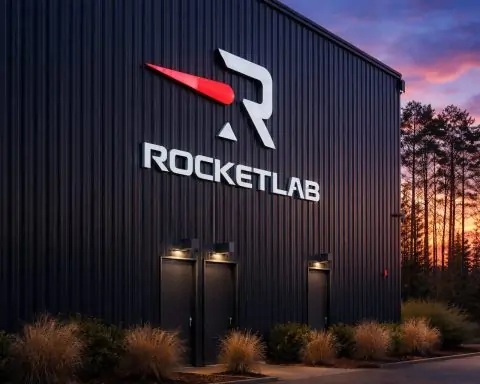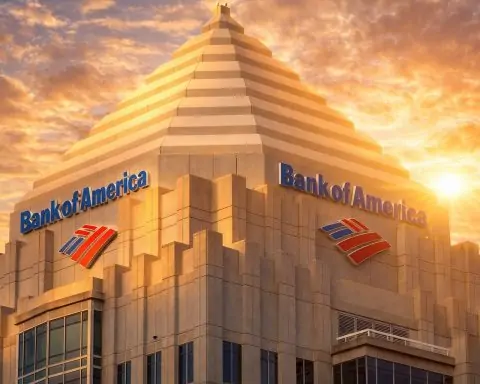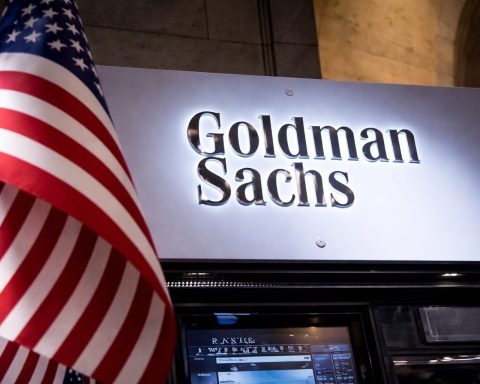- Explosive Rally: Bitfarms Ltd. (NASDAQ/TSX: BITF) has surged roughly +148% year-to-date by mid-October 2025, climbing from about $1 in January to the mid-$4 range – its highest in years [1] [2]. Shares hit a 52-week peak around $6.20 intraday on Oct. 14 amid a crypto frenzy [3].
- Volatility & Pullback: The high-beta stock (β ~4–5) has swung wildly with Bitcoin’s moves [4]. After peaking mid-month, BITF plunged ~40% in five days from Oct. 15–20, as Bitcoin corrected ~14% from its early October record [5] [6]. Bitfarms closed around $4.00 by Oct. 22–23 [7], retracing some gains but still up dramatically in 2025.
- Mining Boom: A historic Bitcoin rally in “Uptober” saw prices blast above $125,000 (USD) for the first time [8] [9] (≈$175k in CAD [10]). Soaring crypto prices have fattened miner profit margins — Bitfarms mined 718 BTC in Q2 at ~$48K cost each, now yielding 2×+ profit per coin with BTC well over $100K [11] [12].
- Major Moves: Bitfarms seized the moment with big initiatives. It raised $500 million (upsized to $588M) via low-interest 1.375% convertible notes due 2031 [13] [14], fortifying its balance sheet. The company also announced a CFO change – veteran financier Jonathan Mir will replace retiring CFO Jeff Lucas on Oct. 27 [15] [16] – and is aggressively pivoting into AI and high-performance computing (HPC) data centers alongside crypto mining [17] [18].
- AI Pivot & Expansion: Armed with cash, Bitfarms is building a 350 MW “Panther Creek” data center campus in Pennsylvania for AI/cloud clients (first 50 MW coming online in 2026) [19] [20]. It partnered with T5 Data Centers and acquired land in PA and Washington State to fuel this HPC diversification [21]. Simultaneously, Bitfarms is exiting unstable regions (shuttering its Argentina mine amid power issues) to refocus on North American sites with cheap, reliable energy [22] [23]. Today over 80% of its 1.3 GW development pipeline is U.S.-based [24].
- Market Environment: A “perfect storm” of tailwinds lifted crypto miners: huge ETF inflows (~$6B in a week) into Bitcoin funds [25] [26], a friendlier U.S. regulatory stance in 2025, and macro trends (weaker USD, record gold) spurring Bitcoin demand as an inflation hedge [27] [28]. However, geopolitical jitters and profit-taking have sparked occasional sell-offs, reminding investors that crypto’s notorious volatility cuts both ways [29] [30].
- Analyst Sentiment Split: Wall Street is cautiously optimistic yet divided on BITF. Six analysts rate it “Buy” vs. one “Sell,” but the average 12-month price target (~$4.35) sits slightly below recent prices [31]. Bulls point to Bitfarms’ “disciplined finances and HPC pivot,” with some setting targets as high as $7 [32]. But skeptics note fundamentals still lag the meteoric stock rise [33] – Bitfarms remains unprofitable (Q2 net loss ~$29M on $78M revenue) [34] and carries a negative 52% profit margin [35]. Independent ratings like Weiss even assign BITF a “D–” sell grade as of early October [36].
- Future Outlook: Experts say Bitfarms’ fate will track Bitcoin’s next moves. Crypto bulls (e.g. Standard Chartered) see BTC rising to $135K–$150K+ in the near future [37] – and Marathon Digital’s CEO even envisions ~$200K within a year [38] – which would be a windfall for miners. Yet bears like Robert Kiyosaki warn of a potential 50% crypto crash before the next big rally [39]. With the 2024 Bitcoin halving looming (cutting miners’ block rewards by 50%), mining difficulty climbing, and energy costs volatile, Bitfarms faces a challenging road to sustain profits. Its new $1+ billion liquidity (cash, BTC holdings, credit and note proceeds) provides a hefty cushion [40] [41], but the company must execute on its AI data center expansion to justify its valuation if Bitcoin’s momentum cools [42] [43].
Bitfarms Stock Soars Amid Crypto Rally
Bitfarms has been one of 2025’s standout stocks, riding the wave of a broader crypto boom. As of mid-October, BITF was up ~148% year-to-date [44] [45], vastly outperforming the market. Over the past six months alone, shares rocketed over +400% [46] in a parabolic climb that saw the price vault from penny-stock levels to multi-year highs. This run-up coincided with Bitcoin’s dramatic resurgence and strategic shifts by Bitfarms – a one-two punch that made BITF one of the fall’s top-performing tech/financial stocks.
The rally reached a frenzy in early October. In the week of Oct. 9–13, Bitcoin’s price shattered its all-time high, blasting through $126,000 per coin on Oct. 5 [47]. Institutional money poured in at record pace (nearly $6 billion into crypto ETFs in one week [48]), and sentiment was euphoric. Bitfarms’ stock, highly sensitive to Bitcoin’s moves, surged even more than the coin itself – a common pattern, as mining stocks often act like leveraged plays on BTC [49]. Traders bid BITF up for five straight sessions to new peaks, with the stock hitting ~$6.20 intraday on Oct. 14 (its highest level in years) before closing that day at $5.89 [50]. At that peak, Bitfarms had risen roughly +397% in just 45 days since September 1 [51], a staggering run. Trading volumes spiked to around 3× the three-month average during the frenzy [52], reflecting intense speculative interest.
Such explosive gains came with equally dramatic swings. Bitfarms’ beta is estimated around 4–5, meaning it tends to move 4–5× more sharply than the overall market [53]. True to form, when sentiment shifted, BITF reversed hard. Starting Oct. 15, the stock entered a swift downturn, ultimately tumbling ~40% in five days by Oct. 20 [54]. On Wednesday, Oct. 22, BITF sank about 14% in a single session on the Toronto Stock Exchange, topping trading volume charts with over 10 million shares traded [55]. This reversal came as Bitcoin itself pulled back ~14% from its high (from ~$175,909 CAD on Oct. 6, down to ~$151K) [56], after an uninterrupted rally. Other crypto miners like Hut 8 and Hive Blockchain similarly slid in that period [57].
By Oct. 23, Bitfarms stock hovered near $4 (USD) – still roughly quadruple its 2023-end price, but well off the mid-October highs [58]. Essentially, BITF gave back a chunk of its “ETF frenzy” gains as the crypto market paused for breath. Analysts had noted the stock’s technical indicators were flashing overbought in early October (the 14-day RSI topped 80+) [59], foreshadowing a pullback. Chart watchers now see support around the low-$4s (≈C$5.65) and near-term resistance around mid-$4s (≈C$6) [60]. In other words, after the roller-coaster rise and fall, BITF is consolidating in a new higher range – still “miles above” where it began the year [61] [62].
Major Moves: CFO Shake-Up and $500 M Financing Windfall
Bitfarms’ breathtaking rally hasn’t been just luck – the company also delivered big news that boosted investor confidence. In the span of a few days in mid-October, Bitfarms unveiled a series of strategic moves aimed at turbocharging its growth beyond Bitcoin mining.
Executive Transition: On Oct. 14, Bitfarms announced that long-time CFO Jeff Lucas will retire, and Jonathan Mir will take over as Chief Financial Officer effective Oct. 27 [63] [64]. Mir is a seasoned infrastructure financier with 25+ years’ experience at Lazard and Bank of America, specializing in energy and power projects [65] [66]. The leadership change is significant: Bitfarms explicitly recruited an energy-infrastructure expert to help lead its pivot into running large-scale data centers. CEO Ben Gagnon stated the move positions Bitfarms to “execute on our HPC/AI growth strategy in Pennsylvania, Quebec and Central Washington” [67]. The outgoing CFO Lucas will stay on as an advisor through Q1 2026 to ensure a smooth transition [68] [69]. This C-suite shake-up follows other recent corporate shifts: over the summer, Bitfarms even re-domiciled its headquarters to the U.S. (opening a New York office and switching to U.S. GAAP accounting) and launched a 10% stock buyback program to retire shares it deemed undervalued [70] [71]. The message from management is clear – they are transforming Bitfarms from a “plain” Bitcoin miner into a broader “energy and digital infrastructure” company [72].
Massive Capital Raise: Perhaps the most impactful development was Bitfarms’ bold financing move. On Oct. 15, with its stock near multi-year highs, Bitfarms announced a $300 million convertible senior notes offering – and demand was so strong that the deal was upsized to $500 million the next day [73]. By Oct. 21, the company closed on $588 million in 1.375% convertible notes due 2031, after full exercise of the underwriters’ $88M overallotment option [74]. This is an enormous war chest for a firm of Bitfarms’ size (over 25% of its market cap in new capital). The notes carry a low fixed coupon of 1.375% and convert to equity at ~$6.86/share – roughly a 30% premium to BITF’s pre-announcement price [75] [76]. In other words, institutional investors were willing to bet that Bitfarms stock will be worth well above $6.86 in the coming years, and Bitfarms took advantage of that optimism to secure cheap financing. “We were able to upsize the deal while improving on pricing… and introduce many high-quality institutional partners into our cap table,” CEO Gagnon noted, calling the debut convertible issuance a “tremendous success” [77] [78]. The fundraising boosts Bitfarms’ liquidity to over $1 billion when combined with existing cash, bitcoin holdings, and an undrawn credit facility [79] [80]. Gagnon said the company now has the “financial firepower and flexibility” to “move forward at full speed” on its growth projects [81] [82].
To reassure shareholders about potential dilution, Bitfarms concurrently entered into “capped call” option transactions as a hedge. These options effectively cap dilution up to a stock price of ~$11.88 (125% above the reference price) [83] [84]. In practical terms, unless Bitfarms stock more than doubles from current levels, the new notes won’t increase the share count (the capped calls offset conversions up to that threshold). Management characterized the financing as an “opportunistic capital raise” to fund expansion while preserving shareholder upside [85] [86]. Initially, the dilution fears did spark some volatility – when the $300M offering was first revealed on Oct. 16, BITF’s stock plunged ~18% intraday as some investors balked at the debt and potential share issuance [87]. But as details of the upsized deal and anti-dilution measures emerged, those fears subsided. By locking in a huge cash influx on favorable terms, Bitfarms effectively front-loaded its growth capital at a strategic moment.
Pivot to AI Data Centers and North American Expansion
A core driver of investor enthusiasm – and a pillar of Bitfarms’ strategy – is the company’s ongoing pivot into high-performance computing (HPC) and AI hosting. Bitfarms is determined to leverage the infrastructure expertise (and cheap energy access) it honed in crypto mining to build large-scale data centers for new markets like artificial intelligence, cloud computing, and machine learning.
One flagship initiative is the Panther Creek campus in Pennsylvania, a planned 350 MW data center complex that will support both Bitcoin mining and third-party HPC clients [88] [89]. In an Oct. 10 announcement, Bitfarms revealed it had converted a $300M credit facility with Macquarie into project-specific financing for Panther Creek, and immediately drew an additional $50M to accelerate construction [90]. The first 50 MW of capacity is expected to go live by 2026, with the campus scaling to as much as 300–350 MW by 2027 [91]. To execute this ambitious build, Bitfarms has partnered with T5 Data Centers, a specialist in enterprise IT infrastructure, for design and development support [92]. It also acquired 181 acres of land in Pennsylvania and a site in Washington State to host future AI computing facilities [93] [94]. The strategic intent is clear: diversify the business by offering “vertically integrated, state-of-the-art” computing infrastructure not just for Bitcoin, but for the booming AI/cloud sector [95] [96]. Management touts that Bitfarms’ background operating power-hungry crypto farms gives it a leg up in running data centers efficiently. By supplying low-cost, reliable computing powered by cheap energy sources, Bitfarms aims to attract AI firms that need massive computing power at scale [97].
At the same time, Bitfarms is streamlining its legacy mining operations to focus on stable, cost-effective regions. Notably, the company is shutting down its 58 MW Bitcoin mine in Argentina after chronic power supply problems and economic turbulence there. (An Argentine energy provider cut off power to Bitfarms’ facility in May 2025 amid the country’s turmoil.) Bitfarms now plans to fully decommission that site by November 2025 [98]. It has negotiated to recover a $3.5M power deposit and exit its obligations in Argentina [99]. This exit aligns with Bitfarms’ broader pivot to North America. Over 80% of its 1.3 gigawatt pipeline of projects is now U.S.-based [100], concentrated in areas with robust power grids and favorable economics. The company still operates multiple Bitcoin farms in Quebec and Paraguay as well [101], but future growth is centered on the U.S. (particularly Pennsylvania and Washington for HPC, plus existing sites in Washington and Quebec for mining). This geographic refocus not only mitigates political and currency risks, it also dovetails with cleaner energy sources and more reliable infrastructure – crucial factors for both Bitcoin mining and AI computing, which are extremely energy-intensive.
The outgoing CFO Jeff Lucas underscored how far Bitfarms has come in this transformation. “During my tenure… [Bitfarms] transitioned from a Bitcoin miner to an HPC/AI infrastructure pioneer,” Lucas reflected in the CFO transition announcement [102] [103]. He noted the company’s balance sheet is “stronger than ever”, with roughly $330M in cash and Bitcoin holdings on hand and up to $250M of additional credit still available for Panther Creek [104] [105]. With the new $500M+ financing on top, Lucas remarked, “we have never been better capitalized… [and] have a long runway of growth” ahead [106] [107]. Indeed, post-financing, Bitfarms now enjoys an unprecedented liquidity position to fund its expansion. This cash pile gives management the flexibility to invest heavily in construction, withstand crypto downswings, and delay any need to dilute shareholders further or turn an immediate profit. Few mining peers have such a luxury – a fact not lost on investors.
Crypto Market Context: Bitcoin’s Boom Lifts Miners, But Risks Loom
Bitfarms’ fortunes remain tightly intertwined with the broader cryptocurrency market, which in 2025 experienced both spectacular highs and bouts of turbulence. The stock’s huge rally was set against what crypto traders dubbed “Uptober” – a historic October bull run for Bitcoin – while its recent pullback coincided with renewed volatility in crypto prices.
In early October, Bitcoin (BTC) broke into six figures for the first time ever, marking a watershed moment for the industry [108]. BTC’s price hit about $125K USD (≈$175K CAD) on Oct. 5–6, eclipsing the previous peak from earlier in 2025 [109] [110]. A confluence of factors drove this surge. Institutional adoption accelerated: crypto-focused ETFs and funds saw nearly $6 billion of inflows in one week – an unprecedented flood of capital into Bitcoin products [111]. This reflected growing mainstream acceptance of digital assets. U.S. regulators, after years of hesitation, appeared to soften their stance: the SEC moved forward on several spot Bitcoin ETF applications (a key legitimizing step for Wall Street) [112], and a new U.S. administration in 2025 signaled a friendlier tone toward crypto mining and blockchain tech, reversing prior crackdowns [113] [114]. Meanwhile, macroeconomic trends boosted Bitcoin’s appeal – the U.S. dollar weakened and gold hit record highs, spurring investors to view Bitcoin as an alternative hedge [115]. “All these factors converged to create a near-perfect environment for Bitcoin miners: high prices, high demand, and improving public perception,” observed a TS2.tech market analyst [116] [117].
For mining companies like Bitfarms, a six-figure Bitcoin is transformative. The revenue per coin mined skyrockets while costs (electricity, operations) remain largely fixed, yielding windfall profits [118]. Bitfarms, for instance, produced 718 BTC in Q2 2025 at an average direct cost of ~$48,200 per BTC [119]. With Bitcoin over $100K, each coin mined brings in more than double that cost in revenue – dramatically improving cash flow. This operating leverage was on full display across the sector: virtually all crypto-mining stocks soared in tandem with Bitcoin’s climb [120]. Bitfarms’ ~19% weekly gain in mid-October made it the #1 performing financial stock (>$2B cap) that week [121] [122]. Peers such as Marathon Digital (MARA) and Riot Platforms (RIOT) also jumped to multi-month highs (Marathon shares popped ~10% in a day to ~$22 [123], Riot’s market cap swelled past $7B [124]). Smaller miners like Cipher Mining (CIFR), Bitdeer (BTDR), and Iris Energy (IREN) saw double-digit gains as well [125]. The entire mining sector essentially rode the rising tide of Bitcoin’s rally.
However, the crypto sea is notoriously choppy. Even within October, not everything was a one-way ascent. After the early-month euphoria, volatility returned. Mid-October brought a reality check: geopolitical news (a U.S.–China trade spat and other macro worries) sparked a brief risk-off move, and Bitcoin slid back to ~$110K [126] [127]. By Oct. 10–11, BTC was experiencing its worst pullback in months, and crypto stocks tumbled in sympathy [128]. That set the stage for the BITF decline after Oct. 15 noted earlier. Another swoon came later in the month when former President Trump announced steep new tariffs on Chinese goods (in retaliation for China’s rare earth export curbs), rattling broader markets and causing a risk asset sell-off [129]. Bitcoin and miners fell sharply on that news, though they rebounded once tensions eased and dip-buyers jumped back in [130] [131]. This pattern underscores a key point for investors: the same leverage that boosts mining stocks on the way up can cut deep on the way down. Bitfarms “is sensitive to Bitcoin prices” and often magnifies BTC’s moves [132] – when Bitcoin jumps, BITF tends to jump higher, and when Bitcoin dips, BITF can drop harder [133].
Looking ahead, crypto-market uncertainty remains high. The next Bitcoin halving (expected in April 2024) will halve the block reward that miners earn, which could squeeze mining revenues unless BTC’s price doubles to compensate. Many analysts anticipate increased mining difficulty and competition as well, given that major miners are racing to expand hash rate capacity [134]. Additionally, energy costs – a critical input for miners – are a wild card. In 2022–2024, global energy prices were volatile; miners that secure low-cost power (as Bitfarms has in Quebec and Washington) will have an edge, but any spike in electricity rates could pressure margins. Bitfarms’ strategy of focusing on energy-abundant regions with stable grids is in part to mitigate this risk [135] [136].
On the positive side, the demand for HPC/AI infrastructure provides a new avenue for growth that is not directly tied to Bitcoin’s boom-bust cycle. The recent partnership between OpenAI and AMD – a deal to deploy 6 GW of cutting-edge GPUs for AI – highlighted how massive the AI compute boom is, and it lifted sentiment for any company linked to data centers [137] [138]. In fact, news of OpenAI’s chip deal and other AI investments has at times bolstered crypto mining stocks like Bitfarms, since investors see parallels in the “surging demand for computing power” that underpins both AI and Bitcoin mining [139] [140]. Bitfarms’ dual positioning in crypto and HPC is an attempt to harness this trend.
Analyst Commentary: Bulls vs. Bears on BITF
With Bitfarms’ stock quintupling at one point this year and then whipsawing, analysts have a wide range of views on where it goes from here. The company’s bold pivot and crypto tailwinds have excited many bulls, but skeptics highlight that Bitfarms’ fundamentals have yet to catch up to its lofty market valuation.
On Wall Street, coverage is modest (typical for a mid-cap crypto stock) but generally positive. According to Bloomberg data, six analysts currently rate BITF a “Buy” and one a “Sell.” However, tellingly, the average price target is about $4.35 – slightly below the recent market price around $4.50–$5 [141]. In other words, even bullish analysts did not foresee the stock rising this high, this fast. A couple of analysts have raised their targets into the $6–$7 range, arguing that Bitfarms’ “disciplined finances and [the] HPC pivot” warrant a premium [142]. They applaud Bitfarms for diversifying its business and strengthening its balance sheet while many rivals were struggling. For instance, Bitfarms’ decision to hodl some Bitcoin and raise cash through debt (instead of dilutive equity at lower prices) earlier in the year showed foresight once the bull run hit. The new CFO hire and share buyback plan also signal confidence from management in the company’s direction. These supporters believe if Bitcoin stays high and the AI data center buildout progresses on track, Bitfarms could grow into its valuation and possibly outperform further.
On the other side, bearish voices urge caution, pointing to Bitfarms’ lack of profitability and dilution risks. The reality is that Bitfarms remains unprofitable on an accounting basis. In Q2 2025 it posted a net loss of ~$29 million despite $78M in revenue [143] [144]. Its profit margins were deeply negative (–35% in Q2), and it slightly missed analysts’ revenue expectations for that quarter [145]. Full-year 2025 earnings are projected to stay in the red (consensus –$0.21 EPS for 2025) [146]. As one analyst summarized, “Fundamentals still lag” the stock’s meteoric rise [147]. Bitfarms’ market cap (~$2.5–2.8B at $5/share) implies very high multiples on any near-term earnings, which “may be stretched relative to its current earnings trajectory,” the analyst cautioned [148]. There’s concern that if crypto momentum falters, BITF’s valuation leaves a lot of downside. Notably, even industry insiders have taken some money off the table: Riot Platforms, a fellow miner that was a significant Bitfarms shareholder, quietly sold shares during Bitfarms’ rally, trimming its stake below 10% [149]. Riot’s move to cash out gains suggests that those in the know felt BITF’s price had run ahead of itself.
Market data also reflect increased short interest and skepticism from quant ratings. The independent rating firm Weiss, for example, assigns Bitfarms a “D–” (sell) grade as of Oct. 8 [150], citing the company’s high volatility and weak earnings quality. And Zacks Investment Research currently ranks BITF a Hold, advising that new investors avoid chasing the stock above $5 given its speculative nature and lagging fundamentals [151] [152]. In a recent analysis, Zacks noted that while Bitfarms’ pivot beyond mining is promising, “the fundamentals aren’t keeping pace with the bullish trajectory.” It highlighted Bitfarms’ negative net profit margin (around –52%) versus the industry average of +0.6%, and continued net losses [153] [154]. Until the AI/HPC ventures start generating meaningful revenue, BITF remains a high-risk play riding on Bitcoin prices and investor sentiment [155].
Outlook: High Hopes Tempered by Crypto Reality
Going forward, Bitfarms sits at the crossroads of two volatile industries – cryptocurrency mining and artificial intelligence infrastructure – each with huge opportunities and significant risks. The bull case for Bitfarms is straightforward: if Bitcoin’s recent strength is the start of another multi-year bull market, and if Bitfarms successfully builds out its data center business, the company could see exponential growth in both its legacy and new segments. Under those rosy conditions, 2025–2026 could be banner years. Some forecasts (e.g. Standard Chartered) suggest Bitcoin could sustain six-figure prices or even climb toward $150K+ barring major macro shocks [156] [157]. Marathon’s CEO predicting $200K BTC within a year may be an outlier, but it underscores the optimism among industry leaders [158]. High Bitcoin prices would continue to inflate Bitfarms’ mining revenue and might finally push the company to net profitability (especially as it adds more efficient miners and benefits from economies of scale). A strong crypto market would also give Bitfarms more internal cash to reinvest in its HPC buildout, reducing reliance on debt or equity markets. In this scenario, Bitfarms’ stock would likely have further upside, potentially justifying the convertible note buyers’ bet on a >$6.86 share price.
Moreover, if Bitfarms can execute on its AI/HPC pivot, it could unlock an entirely new revenue stream that is more stable than crypto mining. The goal is to start bringing Panther Creek’s first phase online in 2026 and attract major clients in the AI/cloud space [159] [160]. Success in signing large enterprise or government customers for its data center capacity would validate Bitfarms’ strategy and diversify its income. Recurring revenue from hosting or cloud services would command higher valuation multiples than the cyclical, commodity-like mining earnings. Bitfarms’ leadership is betting that its “U.S.-focused energy and digital infrastructure strategy” will pay off [161] [162]. If it does, Bitfarms could start to be seen not just as a crypto miner, but as a hybrid tech infrastructure provider riding both the blockchain and AI trends – a narrative that could attract new investors (and potentially higher stock valuations).
The bear case, however, is that Bitfarms faces plenty of hurdles and its current stock price already bakes in a lot of good news. In the near term, crypto volatility is the biggest wild card. As Robert Kiyosaki and others have warned, Bitcoin could easily swoon 30–50% on some unforeseen catalyst [163] – be it a regulatory crackdown, macroeconomic shock, or simply a wave of profit-taking after an extended rally. A major Bitcoin downturn would likely hammer Bitfarms’ stock (due to its amplified sensitivity) and could test the company’s finances if it’s prolonged. Even though Bitfarms has a big cash buffer now, a severe crypto bear market would raise tough questions about return on investment for the new capital being poured into HPC projects, which might take years to fully ramp up. Execution risk is also significant. Building a 300+ MW data center and entering the AI hosting business pits Bitfarms against well-capitalized tech giants and established data center operators [164] [165]. Companies like Amazon (AWS), Microsoft (Azure), and Google, as well as specialized REITs, are all investing billions in AI infrastructure. Bitfarms will need to carve out a niche – perhaps by targeting secondary markets with cheaper power, or leveraging crypto-specific computing demand – to compete successfully [166] [167]. If Panther Creek’s buildout hits delays, cost overruns, or struggles to find customers, the market may grow impatient, especially since Bitfarms’ core business alone has not proven it can generate profits.
Additionally, taking on debt (even cheap debt) introduces long-term obligations. The convertible notes mature in 2031; while interest expense is minimal now, by 2028–2030 Bitfarms may face decisions on conversion or repayment. Depending on how the stock performs, that could mean either dilution (if BITF is well above $6.86, noteholders likely convert) or refinancing pressures (if BITF languishes, the company might have to repay in cash or roll the debt, which could be challenging if credit markets tighten). In essence, Bitfarms has bought time and flexibility with its fundraising – but it must use that time wisely to build a sustainable business model.
For now, investors remain bullish but watchful. The stock’s wild swings in October highlight that sentiment can turn on a dime. “Enthusiasm can quickly turn to fear,” as one market observer noted of Bitfarms’ recent financing news cycle [168] [169]. The coming months will bring important signals: Bitcoin’s trajectory (will it stabilize above $100K, keep rising, or pull back?), Bitfarms’ execution on expansion (hitting milestones like breaking ground on Panther Creek, securing HPC clients), and the broader appetite for risk assets as economic conditions evolve.
Bottom Line: Bitfarms has electrified shareholders in 2025 with a heady mix of crypto-fueled gains and bold strategic moves. It enters late-2025 with significant momentum, a strengthened balance sheet, and a clear vision to become more than just a miner. Yet it also carries high risk, tied to the unpredictable crypto cycle and an unproven foray into AI infrastructure. As one analyst put it, Bitfarms’ story is now about “balancing crypto fortunes and new frontiers” [170]. For public investors, BITF represents a high-reward but high-volatility bet on two of today’s hottest themes – Bitcoin and AI. The company’s next chapters will reveal whether its grand pivot can turn this year’s speculative fervor into lasting shareholder value, or if the stock’s gravity-defying ride will come back to earth. Either way, Bitfarms will be a name to watch on the frontier where blockchain meets big compute.
Sources: Financial reports and press releases from Bitfarms [171] [172]; analysis by TechStock²/TS2.tech [173] [174] and Yahoo Finance/Motley Fool [175] [176]; Zacks Investment Research via Nasdaq [177] [178]; CoinDesk and Reuters market coverage [179] [180]; Bloomberg consensus data; and industry commentary.
References
1. ts2.tech, 2. ts2.tech, 3. ts2.tech, 4. ts2.tech, 5. news.futunn.com, 6. news.futunn.com, 7. news.futunn.com, 8. ts2.tech, 9. ts2.tech, 10. news.futunn.com, 11. ts2.tech, 12. ts2.tech, 13. ts2.tech, 14. news.futunn.com, 15. ts2.tech, 16. ts2.tech, 17. ts2.tech, 18. ts2.tech, 19. ts2.tech, 20. ts2.tech, 21. ts2.tech, 22. ts2.tech, 23. ts2.tech, 24. ts2.tech, 25. ts2.tech, 26. ts2.tech, 27. ts2.tech, 28. ts2.tech, 29. ts2.tech, 30. ts2.tech, 31. ts2.tech, 32. ts2.tech, 33. ts2.tech, 34. ts2.tech, 35. www.nasdaq.com, 36. ts2.tech, 37. ts2.tech, 38. ts2.tech, 39. ts2.tech, 40. www.stocktitan.net, 41. www.stocktitan.net, 42. ts2.tech, 43. ts2.tech, 44. ts2.tech, 45. ts2.tech, 46. ts2.tech, 47. ts2.tech, 48. ts2.tech, 49. ts2.tech, 50. ts2.tech, 51. news.futunn.com, 52. ts2.tech, 53. ts2.tech, 54. news.futunn.com, 55. news.futunn.com, 56. news.futunn.com, 57. news.futunn.com, 58. news.futunn.com, 59. ts2.tech, 60. ts2.tech, 61. ts2.tech, 62. ts2.tech, 63. ts2.tech, 64. ts2.tech, 65. www.sec.gov, 66. www.sec.gov, 67. ts2.tech, 68. www.sec.gov, 69. www.sec.gov, 70. ts2.tech, 71. marketwirenews.com, 72. ts2.tech, 73. ts2.tech, 74. news.futunn.com, 75. ts2.tech, 76. ts2.tech, 77. www.stocktitan.net, 78. www.stocktitan.net, 79. www.stocktitan.net, 80. www.stocktitan.net, 81. www.stocktitan.net, 82. www.stocktitan.net, 83. www.stocktitan.net, 84. ts2.tech, 85. ts2.tech, 86. ts2.tech, 87. ts2.tech, 88. ts2.tech, 89. ts2.tech, 90. ts2.tech, 91. ts2.tech, 92. ts2.tech, 93. ts2.tech, 94. ts2.tech, 95. www.sec.gov, 96. www.sec.gov, 97. ts2.tech, 98. ts2.tech, 99. ts2.tech, 100. ts2.tech, 101. ts2.tech, 102. ts2.tech, 103. ts2.tech, 104. ts2.tech, 105. ts2.tech, 106. ts2.tech, 107. ts2.tech, 108. ts2.tech, 109. ts2.tech, 110. news.futunn.com, 111. ts2.tech, 112. ts2.tech, 113. ts2.tech, 114. ts2.tech, 115. ts2.tech, 116. ts2.tech, 117. ts2.tech, 118. ts2.tech, 119. ts2.tech, 120. ts2.tech, 121. ts2.tech, 122. ts2.tech, 123. ts2.tech, 124. ts2.tech, 125. ts2.tech, 126. www.reuters.com, 127. www.reuters.com, 128. www.reuters.com, 129. www.coindesk.com, 130. www.coindesk.com, 131. www.coindesk.com, 132. ts2.tech, 133. ts2.tech, 134. ts2.tech, 135. ts2.tech, 136. ts2.tech, 137. www.nasdaq.com, 138. www.nasdaq.com, 139. www.coindesk.com, 140. www.coindesk.com, 141. ts2.tech, 142. ts2.tech, 143. ts2.tech, 144. ts2.tech, 145. ts2.tech, 146. ts2.tech, 147. ts2.tech, 148. ts2.tech, 149. ts2.tech, 150. ts2.tech, 151. www.nasdaq.com, 152. www.nasdaq.com, 153. www.nasdaq.com, 154. www.nasdaq.com, 155. news.futunn.com, 156. ts2.tech, 157. ts2.tech, 158. ts2.tech, 159. ts2.tech, 160. ts2.tech, 161. www.sec.gov, 162. www.sec.gov, 163. ts2.tech, 164. ts2.tech, 165. ts2.tech, 166. ts2.tech, 167. ts2.tech, 168. ts2.tech, 169. ts2.tech, 170. ts2.tech, 171. www.sec.gov, 172. www.stocktitan.net, 173. ts2.tech, 174. ts2.tech, 175. news.futunn.com, 176. news.futunn.com, 177. www.nasdaq.com, 178. www.nasdaq.com, 179. www.coindesk.com, 180. www.reuters.com







